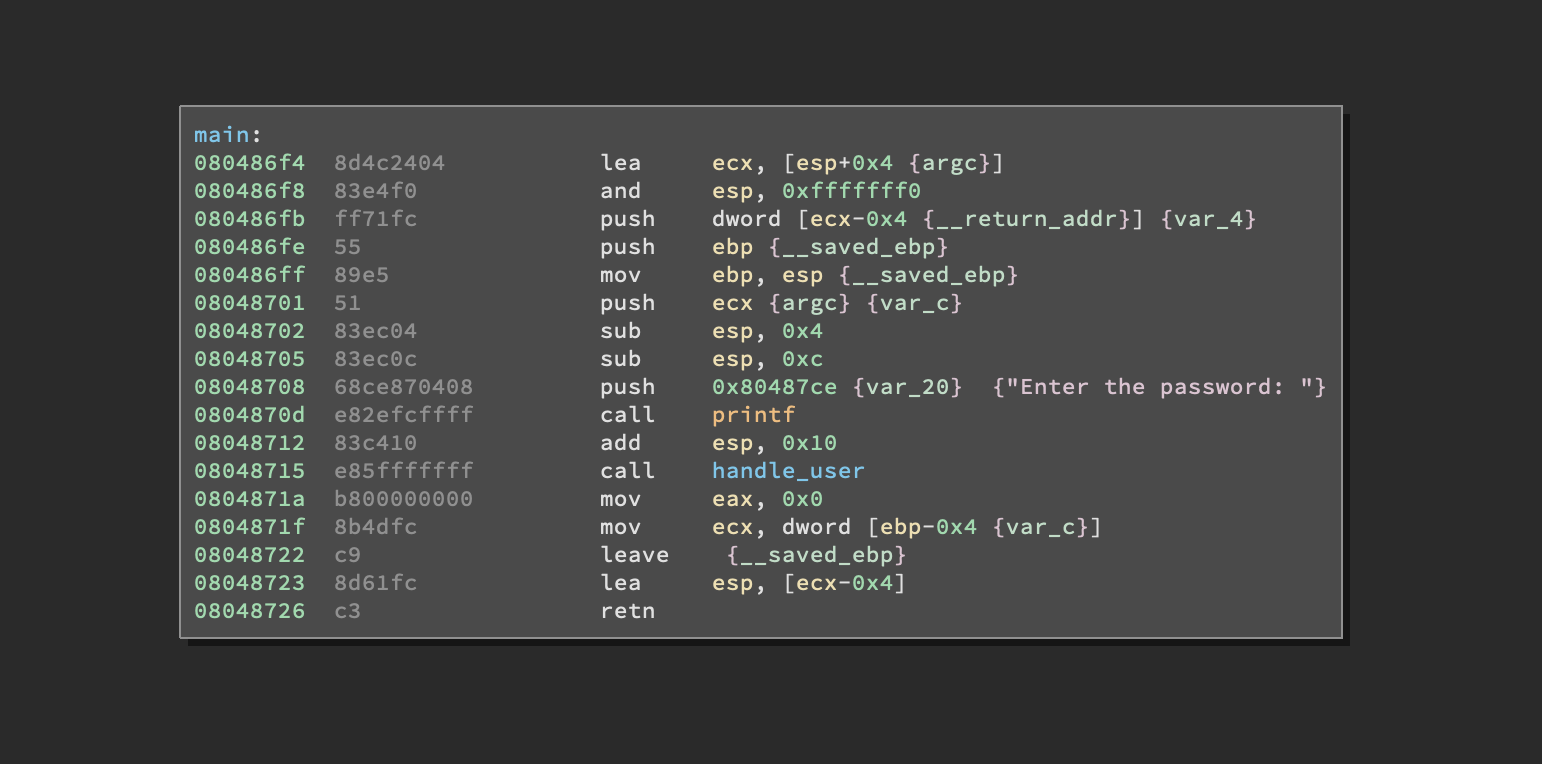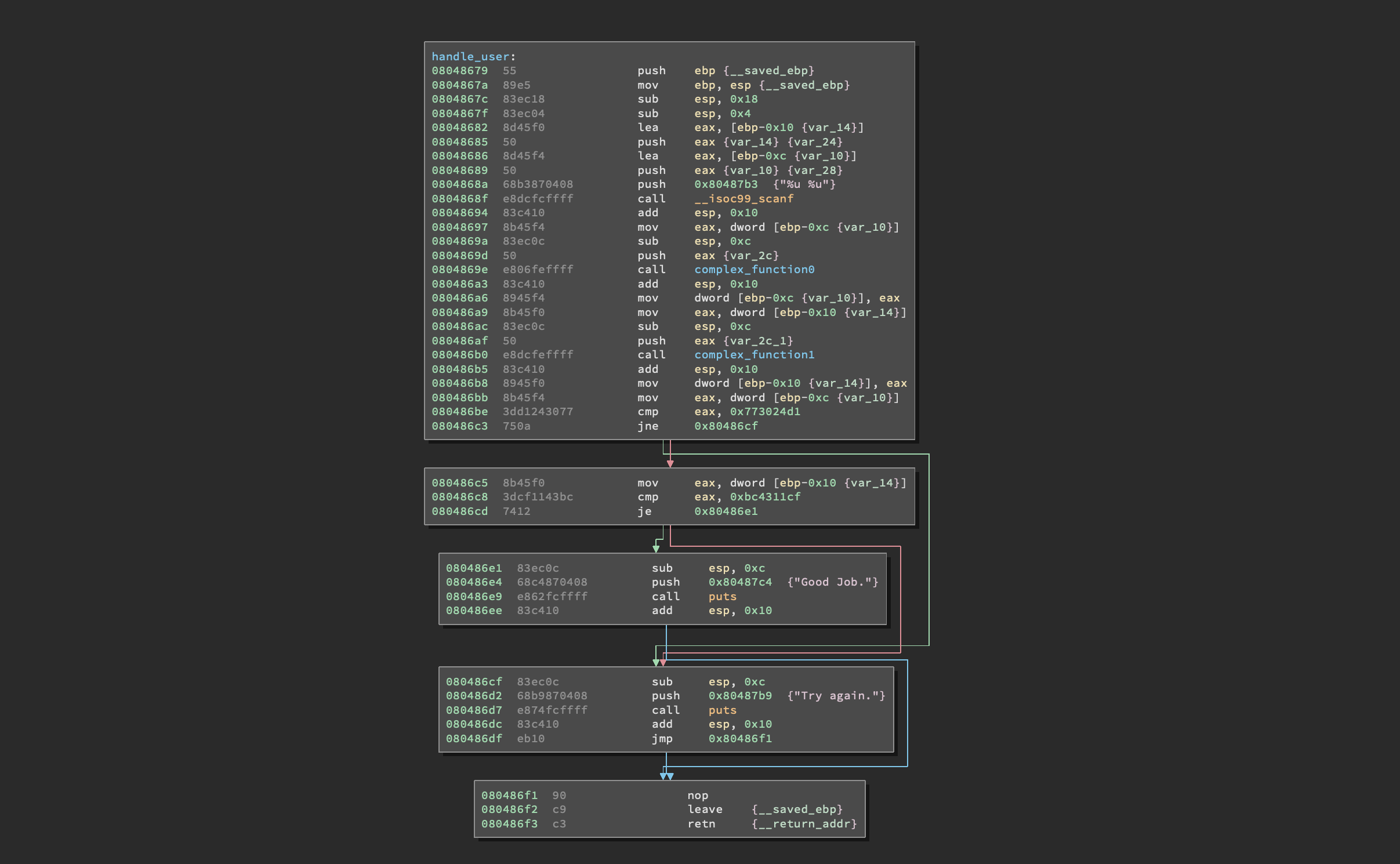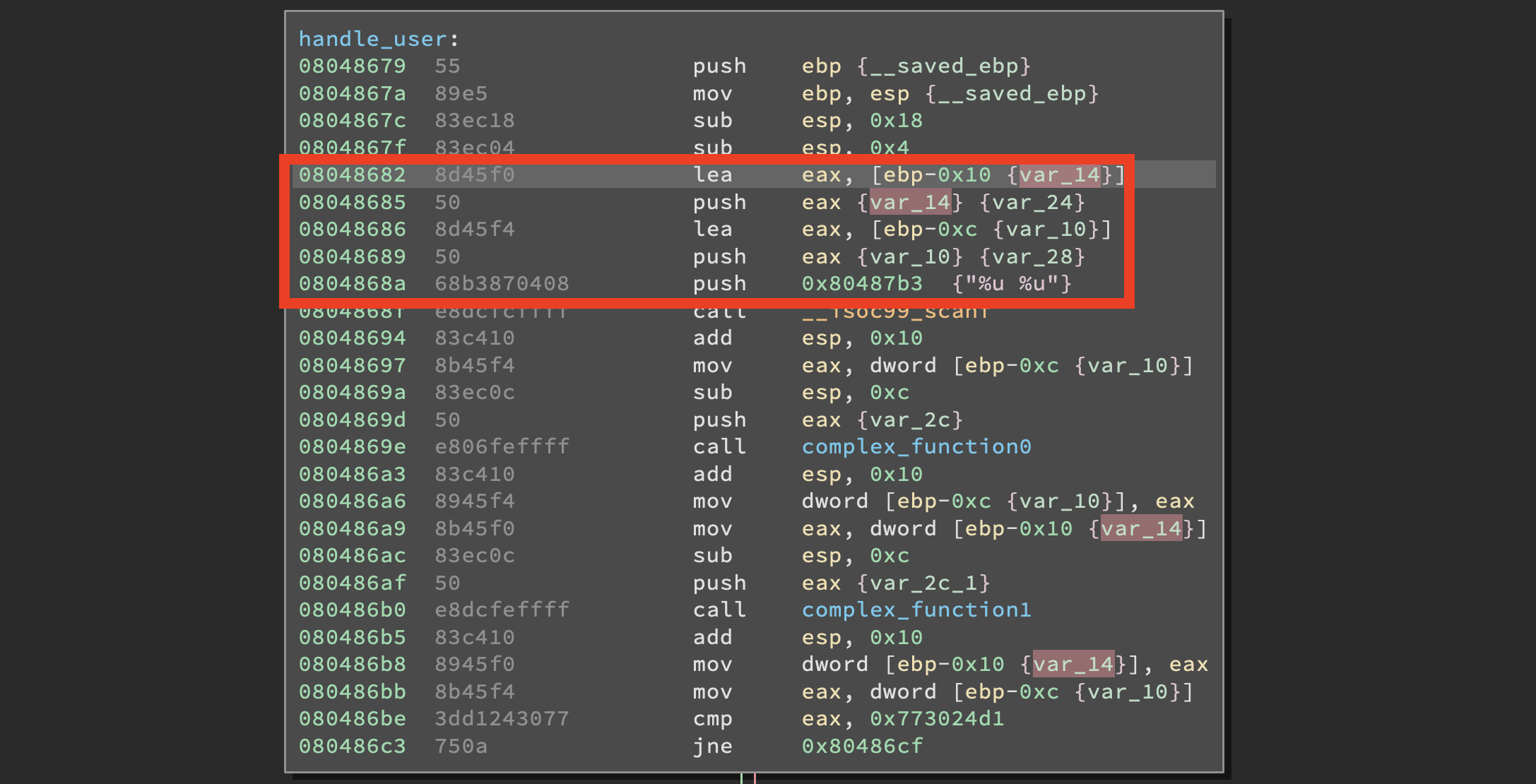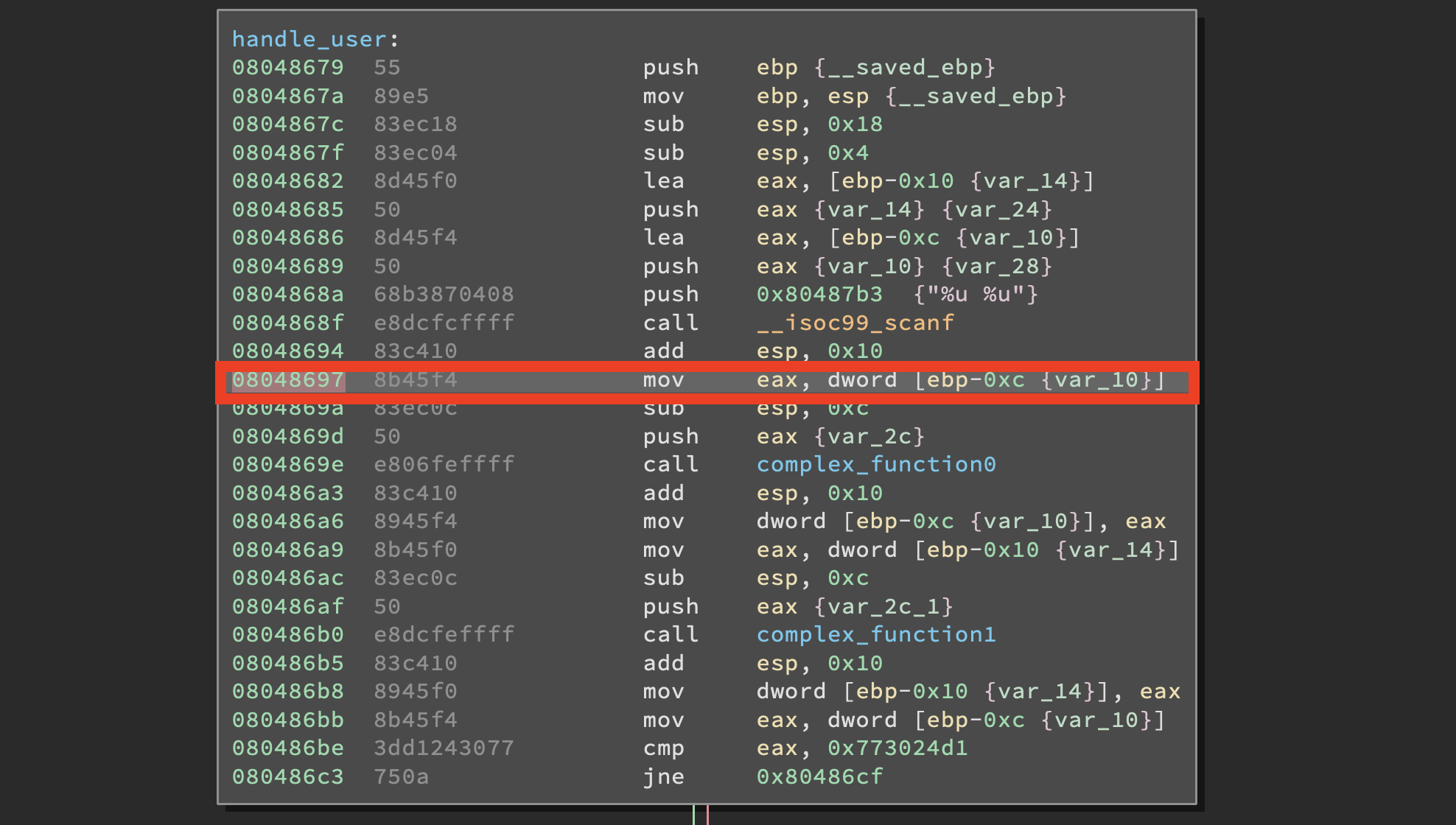Searching on Google how to combat writer’s block and blank page fear? Check. I really don’t know how to start this time, probably because I’m distracted so let’s dive right into it.
In the last post we learnt how to inject a symbolic bitvector inside a register using angr and how to avoid unwanted code paths, but we shamelessly gracefully skipped landing right in the middle of a function and having to construct a stack frame for the function from scratch. In this post we will (hopefully) learn how to do it.
04_angr_symbolic_stack
First let’s take a look at the challenge

Ok ok, nothing that bad here, let’s move on to the handle_user() function

Awww, look at that. Look at the pretty “complex” format string that angr seems to love so much. Also note that before pushing the format string and calling scanf() the program pushes on the stack the addresses of two local variables, [EBP - 0x10] and [EBP - 0xC]

So, standard angr binary challenge? Not quite, this time the variables are stored on the stack and not in registers like the last challenge, that means we will have to cast some stack wizardry in order to push a symbolic buffer without fucking everything up crashing the program. Let’s do a recap of what we know so far:
main()callshandle_user()handle_user()callsscanf()with a complex format stringscanf()puts the two values insidehandle_user()’s stack frame @[EBP - 0x10]and[EBP - 0xC]- life sucks and I should probably get a job instead of doing dumb shit on the internet
Anyway, now we have a “clear” understanding of what the binary does, let’s look at the skeleton solution, scaffold04.py (I edited out most of the comments for brevity’s sake)
import angr
import claripy
import sys
def main(argv):
path_to_binary = argv[1]
project = angr.Project(path_to_binary)
start_address = ???
initial_state = project.factory.blank_state(addr=start_address)
initial_state.regs.ebp = initial_state.regs.esp
password0 = claripy.BVS('password0', ???)
...
padding_length_in_bytes = ??? # :integer
initial_state.regs.esp -= padding_length_in_bytes
initial_state.stack_push(???) # :bitvector (claripy.BVS, claripy.BVV, claripy.BV)
...
simulation = project.factory.simgr(initial_state)
def is_successful(state):
stdout_output = state.posix.dumps(sys.stdout.fileno())
return ???
def should_abort(state):
stdout_output = state.posix.dumps(sys.stdout.fileno())
return ???
simulation.explore(find=is_successful, avoid=should_abort)
if simulation.found:
solution_state = simulation.found[0]
solution0 = solution_state.se.eval(password0)
...
solution = ???
print solution
else:
raise Exception('Could not find the solution')
if __name__ == '__main__':
main(sys.argv)
Instead of modifying it right away let’s devise a strategy first. We need to decide where angr should start. Since we need to skip the scanf() we will start from the instruction located @ 0x8048697. We are going to skip the ADD ESP, 0x10 right after the scanf() because this instruction clears the stack after scanf() returns, but since we are not calling it there’s no need to clear anything.

Now we need to understand how all the instructions we skipped manipulate the stack in order to work out the exact position of the symbolic bitvectors we are going to inject. We know from before that the two values we want to inject are located @ [EBP - 0x10] and [EBP - 0xC] so we need to pad the stack before pushing them, but first we need to tell EBP where in memory it should point. To do so we are going to do with angr what the function prologue (that we are skipping) does: MOV EBP, ESP. After that we are going to decrease the stack pointer and push our values. But how much padding do we need exactly?
We know that the lowest of the two values is located @ [EBP - 0xC], but since it is a 4 byte value it will occupy the following addresses: | 0xC | 0xB | 0xA | 0x9 |. That means we need to pad 8 bytes before pushing on the stack the first value and then the second. After pushing the values on the stack we should be ready to go, let’s take a look at how we are going to modify the script
def main(argv):
path_to_binary = "04_angr_symbolic_stack"
project = angr.Project(path_to_binary)
start_address = 0x8048697
initial_state = project.factory.blank_state(addr=start_address)
Nothing special here, we updated the path_to_binary variable as usual and set the start_address to the value of the instruction following the stack cleaning instruction of the scanf() function we saw before. Now it’s time to start working on the stack, first we perform the MOV EBP, ESP instruction we mentioned before and we are going to do it using angr’s methods
initial_state.regs.ebp = initial_state.regs.esp
After that we are going to decrease by a value of 8 the stack pointer (remember that the stack grows downwards so we are increasing its size actually) to provide padding before pushing our symbolic values on the stack.
padding_length_in_bytes = 0x08
initial_state.regs.esp -= padding_length_in_bytes
Now it’s time to create our symbolic bitvectors and push them on the stack. Remember that the program expects two unsigned integer values (we understood this by the %u %u format string)so the size of the symbolic bitvectors will be 32 bits as this is the dimension of a unsigned integer on a x86 architecture.
password0 = claripy.BVS('password0', 32)
password1 = claripy.BVS('password1', 32)
initial_state.stack_push(password0)
initial_state.stack_push(password1)
After that the rest is basically identical to the previous scripts, we just have to solve the symbolic bitvectors and print them.
if simulation.found:
solution_state = simulation.found[0]
solution0 = (solution_state.solver.eval(password0))
solution1 = (solution_state.solver.eval(password1))
print("[+] Success! Solution is: {0} {1}".format(solution0, solution1))
else:
raise Exception('Could not find the solution')
And this is the final script
import angr
import claripy
import sys
def main(argv):
path_to_binary = "04_angr_symbolic_stack"
project = angr.Project(path_to_binary)
start_address = 0x8048697
initial_state = project.factory.blank_state(addr=start_address)
initial_state.regs.ebp = initial_state.regs.esp
password0 = claripy.BVS('password0', 32)
password1 = claripy.BVS('password1', 32)
padding_length_in_bytes = 0x08
initial_state.regs.esp -= padding_length_in_bytes
initial_state.stack_push(password0)
initial_state.stack_push(password1)
simulation = project.factory.simgr(initial_state)
def is_successful(state):
stdout_output = state.posix.dumps(sys.stdout.fileno())
#print(stdout_output)
if b'Good Job.\n' in stdout_output:
return True
else: return False
def should_abort(state):
stdout_output = state.posix.dumps(sys.stdout.fileno())
if b'Try again.\n' in stdout_output:
return True
else: return False
simulation.explore(find=is_successful, avoid=should_abort)
if simulation.found:
solution_state = simulation.found[0]
solution0 = (solution_state.solver.eval(password0))
solution1 = (solution_state.solver.eval(password1))
print( solution0, solution1))
else:
raise Exception('Could not find the solution')
if __name__ == '__main__':
main(sys.argv)
Let’s test it!

Cool, it works! We are starting to get a grasp on how angr works, maybe next time we will see how to use it in a real CTF. This post ends here, see you at the next one!